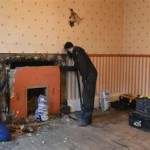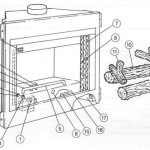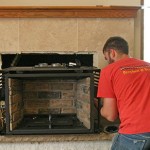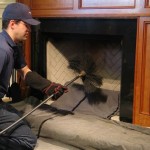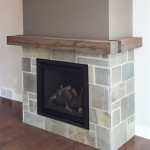```html
Fireplace Door Seal Replacement: A Comprehensive Guide
Maintaining an efficient and safe fireplace hinges significantly on the condition of its door seal. A compromised seal allows air leakage, impacting heating efficiency, potentially increasing energy costs, and posing safety risks. Replacing the fireplace door seal is a relatively straightforward task that can yield considerable benefits. This article provides a detailed guide to understanding the importance of the seal, identifying when replacement is necessary, selecting the right type of seal, and executing the replacement process effectively.
Understanding the Importance of a Fireplace Door Seal
The primary function of a fireplace door seal is to create an airtight barrier between the fireplace firebox and the living space. This barrier serves several crucial purposes. Firstly, it prevents unwanted drafts from entering the home when the fireplace is not in use. Without a proper seal, cold air can be drawn down the chimney and into the room, negating the effects of the home heating system and increasing energy consumption. Secondly, the seal prevents the uncontrolled escape of smoke and combustion byproducts into the living area. Carbon monoxide, a colorless and odorless gas produced during combustion, is a significant health hazard. A compromised seal can allow this gas to leak into the home, posing a serious risk to occupants.
Furthermore, the seal contributes to the efficient operation of the fireplace. By controlling airflow into the firebox, the seal helps to regulate the burning process. This regulation ensures that the fire burns efficiently, maximizing heat output and minimizing the production of smoke and creosote. Creosote is a flammable substance that accumulates in the chimney over time. Excessive creosote buildup increases the risk of chimney fires. A properly functioning door seal, therefore, plays a role in reducing creosote buildup and promoting overall fireplace safety. Finally, a good seal helps to protect the fireplace doors themselves. By preventing excessive heat from escaping around the edges of the doors, the seal can help to prolong their lifespan and prevent warping or other damage.
Identifying the Need for Fireplace Door Seal Replacement
Several indicators suggest that a fireplace door seal needs replacement. A visual inspection is often the first step in determining the seal's condition. Look for signs of wear and tear, such as cracks, brittleness, or disintegration of the seal material. If the seal appears damaged or deteriorated, it is likely no longer providing an effective barrier. Another indication is a noticeable draft coming from around the fireplace doors when the fireplace is not in use. This draft suggests that air is leaking through gaps in the seal. A simple test involves lighting a match or candle and holding it near the edges of the fireplace doors. If the flame flickers or is drawn inward, it indicates air leakage and a compromised seal.
Smoke escaping into the room when the fireplace is in use is a clear sign of a failing seal. This issue not only reduces the efficiency of the fireplace but also poses a health hazard. Increased energy bills, particularly during periods of cold weather, can indirectly indicate a problem with the fireplace door seal. If the home heating system is working harder to maintain a comfortable temperature, it could be due to drafts entering through a compromised fireplace seal. Finally, if the fireplace doors are difficult to close or latch, this could be caused by a deteriorated or compressed seal that no longer provides adequate cushioning and sealing. In such cases, replacing the seal can often resolve these issues and restore proper door function.
Selecting the Correct Type of Fireplace Door Seal
Choosing the correct type of fireplace door seal is essential for ensuring a proper fit and effective performance. Several types of seals are available, each with its own characteristics and suitability for different fireplace door designs. One common type is fiberglass rope seal. Fiberglass rope seals are heat-resistant and durable, making them a popular choice for fireplace doors. They are available in various diameters to accommodate different gap sizes. Self-adhesive fiberglass tape is another option. This type of seal is easy to install and provides a good seal for smaller gaps. It is particularly well-suited for replacing seals on fireplace doors with a shallow channel for the seal.
Silicone rubber seals are known for their flexibility and resistance to high temperatures. They are often used in fireplace doors where a tight, conforming seal is required. Ceramic fiber seals offer excellent heat resistance and are suitable for high-temperature applications. Graphite-impregnated seals provide enhanced lubrication and durability, reducing friction between the door and the seal. When selecting a seal, it is crucial to measure the existing seal or the channel in the fireplace door to determine the correct diameter or width. Using a seal that is too small will result in gaps and air leakage, while a seal that is too large may be difficult to install and could prevent the doors from closing properly. Consulting the fireplace door manufacturer's specifications or seeking advice from a fireplace professional can help in selecting the appropriate type and size of seal for a specific fireplace model.
Tools and Materials Required for Replacement
Before commencing the fireplace door seal replacement, gathering the necessary tools and materials is essential. The required tools typically include a putty knife or scraper for removing the old seal, a wire brush for cleaning the seal channel, measuring tape or ruler to determine the seal length, scissors or a utility knife for cutting the new seal, and adhesive (if required) for securing the new seal. The essential materials consist of the replacement fireplace door seal, appropriate adhesive (if the seal is not self-adhesive), and safety glasses and gloves to protect against debris and potential irritants. A dust mask may also be advisable, especially when working with old, potentially dusty seals.
Ensure that the replacement seal matches the specifications of the original seal or the manufacturer's recommendations. Using an incompatible seal may lead to inadequate sealing and compromise the fireplace's safety and efficiency. Having all the required tools and materials readily available will streamline the replacement process and minimize delays. Furthermore, preparing the work area by laying down a drop cloth or newspaper will prevent debris from soiling the surrounding areas. This preparation also facilitates cleanup after the replacement is complete.
Step-by-Step Guide to Fireplace Door Seal Replacement
The following steps outline the process for replacing a fireplace door seal. First, ensure that the fireplace is cool and that the doors are accessible. Open the fireplace doors completely and, if possible, remove them from their hinges to provide easier access to the seal channel. Then, using a putty knife or scraper, carefully remove the old fireplace door seal. Work slowly and gently to avoid damaging the seal channel. If the old seal is stuck, applying a small amount of heat with a heat gun (used cautiously) can help to soften the adhesive and make removal easier. Be careful not to overheat the surrounding metal, as this could damage the finish.
Once the old seal is removed, thoroughly clean the seal channel with a wire brush to remove any remaining adhesive, debris, or residue. A clean channel will ensure proper adhesion of the new seal. Next, measure the length of the seal channel where the new seal will be installed. Use the measurement to cut the new seal to the appropriate length, adding a small amount of extra length for overlap or trimming as needed. Apply adhesive to the seal channel, if required by the type of seal being used. Follow the manufacturer's instructions for applying the adhesive, ensuring that it is evenly distributed across the channel. Carefully press the new seal into the seal channel, ensuring that it is properly seated and aligned. Start at one end of the channel and work your way to the other, applying firm and even pressure. If the seal is self-adhesive, peel off the backing and press the seal firmly into place.
After the seal is installed, trim any excess material with scissors or a utility knife. This step ensures a clean and professional finish. If the fireplace doors were removed, reattach them to their hinges. Close the doors and check for a tight seal. There should be no gaps or air leaks around the edges of the doors. If any gaps are present, readjust the seal or apply additional adhesive as needed. Allow the adhesive to dry completely before using the fireplace. Follow the adhesive manufacturer's instructions for drying time, which typically ranges from a few hours to overnight. Once the adhesive is dry, the fireplace is ready for use. Test the fireplace by lighting a small fire and observing for any smoke leakage or drafts. If the replacement was successful, the fireplace should operate efficiently and safely.
Safety Precautions During Fireplace Door Seal Replacement
Adhering to safety precautions is paramount during fireplace door seal replacement. Prior to commencing any work, verify that the fireplace is entirely cool to the touch. Working on a hot fireplace can result in severe burns. Wear safety glasses to safeguard the eyes from debris generated during the removal of the old seal and cleaning of the seal channel. Use gloves to protect the hands from sharp edges, adhesive chemicals, and potential irritants present in the old seal material. A dust mask is advisable to prevent inhalation of dust and debris, especially when dealing with old or deteriorated seals.
If a heat gun is utilized to soften stubborn adhesive, exercise caution to avoid overheating the surrounding materials. Excessive heat can damage the finish of the fireplace doors or even cause structural damage. When using sharp tools like utility knives or scissors, always cut away from the body and exercise care to prevent accidental cuts. Ensure adequate ventilation in the work area, particularly when using adhesives or solvents. Fumes from these substances can be harmful if inhaled in concentrated amounts. After completing the replacement, properly dispose of the old seal and any used materials in accordance with local regulations. By following these safety precautions, the risk of injury or accidents during the fireplace door seal replacement process can be significantly minimized.
```
Replacement Gasket Kit Valcourt Lafayette Ac06730

Wood Stove Gaskets A Complete Guide Including Replacement

Woodstove Door Gasket Replacement An Easy Necessity

Stove Gaskets Gasket Kits Spools

Bis Tradition Montecito Estate Pr Sr1823i Sr1685c Sr1823j

Easy Fireplace Insert And Wood Stove Gasket Finder

Replace Wood Stove Door Seal

Stove Fireplace Door Rope Gasket Seal Replacement

Wood Stove Gasket For Burning Replacement Kit Fireplace Seal Doorseal Ca

How Often Should I Replace The Door Gasket On My Wood Burning Stove Heat Answers
Related Posts

